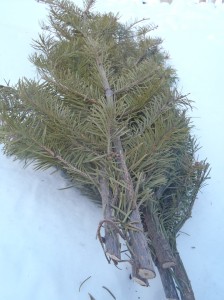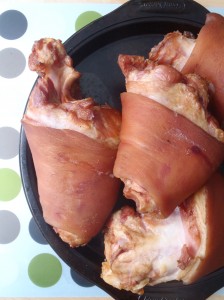 If you consult a North American resource on smoking meat, you’re likely find something like the following:
If you consult a North American resource on smoking meat, you’re likely find something like the following:
The first rule of smoking meat: use hardwood. Apple, hickory, maple, oak, pear, cherry, whatever you please, but do not use soft wood, and especially not evergreens. They are extremely resinous, and not only do they produce harsh, turpentine flavours in the meat, they are also poisonous!
These comments are discouraging to someone who lives where the prairies meet the boreal forest. Of course there are hardwood trees in Edmonton, but they’re not nearly as common as, say, poplars and spruce. There’s a spruce tree in my front yard that, if left to its own devices, will someday eat my house. There’s a fir tree in my living room right now, and in the new year I’ll put it on the curb and the city will take it away. Too bad I can’t use any of that resinous wood, or any of those perfumed needles, to flavour my cured meat…
A lone sentence in Larousse recently changed how I look at my Christmas tree: “Westphalian ham is… cold-smoked over strongly resinous wood.” After a little more research I found that there are several German hams that are smoked with wood from evergreens. Black forest ham, for instance, is smoked over fir. (That is, real black forest ham is smoked over fir: while black forest ham is a protected designation in Europe, in Canada and the States the name can be applied to the many inferior knock-offs.)
I decided to try smoking some brined ham hocks with balsam fir needles and twigs. Usually I am an all-or-nothing sort of cook, but at the last minute I decided to temper my fir trim with conventional hardwood chips.
 Once the smoke got going I could smell the pronounced sweetness of the hardwood, spiked with some harshness from the softwood, specifically, the smell of burning tar, reminiscent of cigarettes.
Once the smoke got going I could smell the pronounced sweetness of the hardwood, spiked with some harshness from the softwood, specifically, the smell of burning tar, reminiscent of cigarettes.
I was really hoping to get a striking layer of black soot from the fir, but the final colour of the hocks was the same mahogany that you get from conventional hardwood smoking.
Hardwood smoke can be sickly sweet and strong of vanilla, but the pine and tar flavours of the fir added some complexity to the finished hams. The smoking process still needs a lot of work. There are lots of questions to be answered:
- Which part of the tree should be used: the needles, the wood, or both?
- Should the needles or wood be fresh? Dried? A combination of dried and soaked?
- Hot smoke or cold? Perhaps cold-smoking mutes some of the harsher characteristics of evergreen smoke?
At this point all I can say is that there is some potential for a good regional specialty.